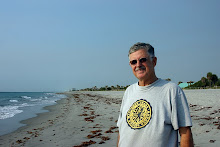1956 – 1957 Fort Lauderdale Sunrise Wreck salvage history.
The initial cultural deposit was discovered by Charles & John Noyes in 1956 while collecting tropical fish.
It looked like there was man-made debris here. A gentle blow to the area with a crowbar released a telltale black, iron sulphide cloud, confirming our suspicions. Fanning around by hand, it was’t long before we brought up a couple Spanish milled silver coins. We were then hooked on working the site whenever we could for the next couple of years.
Actually, this deposit was only that, a deposit. This was not the ship's remains, however pieces of the ship are scattered in a long debris field in a westerly direction. Apparently, the ship was caught up in a heavy storm, or hurricane that swept it onto the seaward edge of Hillsboro Ridge, a shallow reef running parallel to shore about a half mile off Fort Lauderdale beach, and where the water's depth is 12 to 15 ft. depending upon the stage of the tides. It was caught up there long enough for the hull to be breached and the debris to be deposited.
This deposit was spread in a north/south direction for 15 to 20 feet along this reef. This is where all of the recovered artifacts were found. The entire area was cemented with encrustations and was hard to break loose. We used crowbars with some success. However, the really tough material was broken loose using a 30 pound 6 foot jackhammer rod, with a chisel point, as a high-leverage pry bar. We worked carefully so as not to damage individual artifacts. The larger iron pieces, once broken away from the deposit mass, were moved east a few feet to gain access to the deposit, where they still are to this day.
Note: Underwater archaeologists today would condemn such heavy handed destruction of a cultural deposit. Please remember that the deposit was worked in 1956 & 1957 when underwater archaeology did not exist, or was in it's infancy. Now the State of Florida protects it's Underwater Cultural Heritage (UCH).
Recovery of these artifacts by us was fortunate in that the collection has been kept intact, with a few exceptions (noted later). Considering the very shallow depth of the site, the and ever increasing number of divers entering the coastal waters here, I think this find was truly an exceptional experience.
We found many artifacts, including an incomplete brass sextant with what looks like a silver calibration inlaid in the arc and bearing the inscription “W. Hogg, London”, two halves of what appear to be a brass cannon ball mold (recently these have been described as possibly being filials for maybe bedposts), brass spikes, a silver or pewter spoon with the inscription “P. Barnes & Co., London”, a bronze marlin spike, a couple of brass hinges, a brass doorknob, a brass padlock, a few small pieces of coal, over 40 Spanish milled silver coins ranging in date from 1774 through 1839, around 60 Spanish milled silver coins and pieces of milled coins in various poor conditions, a sounding lead, lots of glass pieces including some wine and champagne bottle necks and bottoms, and assorted pottery pieces (one with a stamped mark of English, origin identified by Christopher R. Eck, MA, JD).
We discovered that the substrate here contained potholes up to 10 inches deep. Many of the coins were found by fanning the sand and debris out of these potholes. However, their quality was generally poor due to lack of contact with a sacrificial metal as well as the anaerobic or semi-anaerobic conditions at the bottoms of potholes.
The ship’s registry is possibly British based upon the several of the artifacts, but that is unconfirmed, and the ship's name is unknown.
Subscribe to:
Post Comments (Atom)

No comments:
Post a Comment